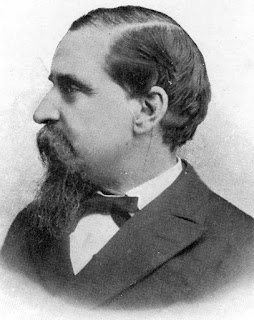Countess Donna Blanca d’Equevilley
with sons Gerald and Goree (From author's private collection)
Today, when we reminisce of
But, our history can lend much more to the imagination then just the backwoods of Florida.
How about a story of mid 19th century European royalty-- A story of mystery, intrigue, and knightly deeds?
That’s right royalty right here in Pasco County
This story behind Pasco ’s
royal connections begins in Segedin on March 6, 1856, with the birth of the
Countess d’Equivelley — then known as D. Baroness Von Feilitzsch.
Born into one of the oldest family’s of European ancient
nobility, the first records of the Feilitsch family name date to the year 1296
— recognized for their knightly deeds and acts of valor.
Among their lineage was Mortiz Feilitzcsh who was named as a
knight of the Holy Grail.
Following the birth of the Baroness Von Feilitzsch in 1856, her father,
O. Baron Von Feilitzsch, was given charge of Reus
in Hesse , and, accompanied by his family, took
his residence at the castle in Gettenbach.
It was there the young Baroness Von Feilitzsch became a lady-in-waiting
to the Princess of Eisenberg, a cousin of the former King Louis XVI of France .
Through the influences of the young Princess, the baroness then received
her appointment as lady-in-waiting to the court of the Prince of Saxe-Coburg
and Gotha . In
these duties she attended on Princess Louise Marie of Belgium , the eldest
daughter of King Leopold.
From Coburg ,
the Baroness returned to Dresden-Saxony where she attended the Princess of Solms,
until the fateful day of the princess’ suicide.
After those tragic circumstances the Baroness Von Feilitzsch
left her duties to care for her ailing father who was recuperating in Mantenvers , France
This is where our noble story blossoms into one of romance.
There, she met a young French nobleman who was studying
forestry with the intent of receiving an appointment on the estates of Compte
de Rochambeau-- this young Frenchman the D. Count de Equevilley, son of D.
Marquis de Equevilley from the noble lineage of Ecquevilly , France
The two young people fell in love and, much to the dismay of
the baroness’ father, were married in September 1878.
While political troubles in France were on the rise, the Count
d’Equevilley’s appointment to the estate of Compte de Rochambeau failed to
materialize.
Soon after their marriage, the countess received a letter from
her brother, A. Baron Von Feilitzsch, asking the newlyweds to join him in Florida where he had recently invested in considerable
acreage and grove lands in the Lake Weir community of Marion County
They graciously obliged the offer and soon after purchased a
home in the little town of Summerfield , Florida .
And, keeping with the customs of their home country, the walls
of their new abode were adorned with the family’s ancestral arms — an
intriguing sight to most of the locals.
In Summerfield, Count d’Equevilley took to farming while the countess became
a house wife-- a seemingly simple life.
In September 1883, they had their first child, a male, who,
in the traditions of the aristocratic titles, would have become the Viscount
Guy d’Equevilley.
But, in their new southern life-style, they attempted to
avoid these pomp royal titles and became widely known among the Summerfield community
simply as Mr. and Mrs. Count.
The d’Equevilley’s remained residents of Summerfield for
nearly 25-years, but in 1906, four years after the count purchased 40 acres of
pine land in Hudson , they decided to move to Pasco County
Settling in the little Catholic town of San Antonio in east Pasco, where they knew no one, they
formally dropped their royal titles and quietly became Mr. and Mrs. Equevilley.
Madame Equevilley made significant investments in San Antonio real estate.
For $250, she purchased two lots northwest of St. Anthony
Catholic Church from Mary L. Scott Gailmard — now the location of the Jiffy
Store and Deli at the intersection of State Road 52 and College Avenue .
She also acquired 20-acres just west of town and a small
bungalow home on two-acres of prime real estate on the north side of the San Antonio town plaza.
In 1915, Goree Acosta, the youngest Equevilley son, enrolled
at St. Leo College for what would be his only semester — dropping out after a
nasty land dispute between his father and St. Leo Abby over 40 acres.
Following this 1915-16 land dispute which eventually
ended in a favorable court ruling for St. Leo Abby, Count and Countess
Equevilley separated, but were never legally divorced.
While Count Equevilley returned to his farm in Summerfield, purporting to most that he was a widower, the Countess Equevilley remained in Pasco County with the boys —
Romaine, Goree, and Gerald Allen an adopted son.
Following a dispute between the school board and the St. Anthony Catholic School, in September 1918, she became the saving graces of public
education in San Antonio — offering her downtown
bungalow to the school board for use as the San Antonio public school.
After the school board visited San Antonio , an arrangement was reached and
Madame Equevilley agreed to sell the lot and bungalow home situated on the west
side of today's Joe Herrmann Drive ,
near McMullen Drive .
In 1926 she made her only return trip back to her home
country for business. However, after settling in Pasco County
In 1944, at age 88, Madame Blanka Von Feilitzsch-
d’Equevilley died at her San Antonio
home and was afterwards cremated.
Following her death, her son, Viscount Romaine F. Equevilley,
became Pasco ’s last
surviving male descendent of the noble Feilitzsch- d’Equevilley families.
He lived the remainder of his life in Hudson with his wife, Dora, and three
children — Baroness Shirley d’Equevilley, Baron Goree J. d’Equevilley, and
Baroness Astrid d’Equevilley.
Having dropped their noble titles, few in Hudson knew of this family’s royal lineage.
Today, the story of Pasco

